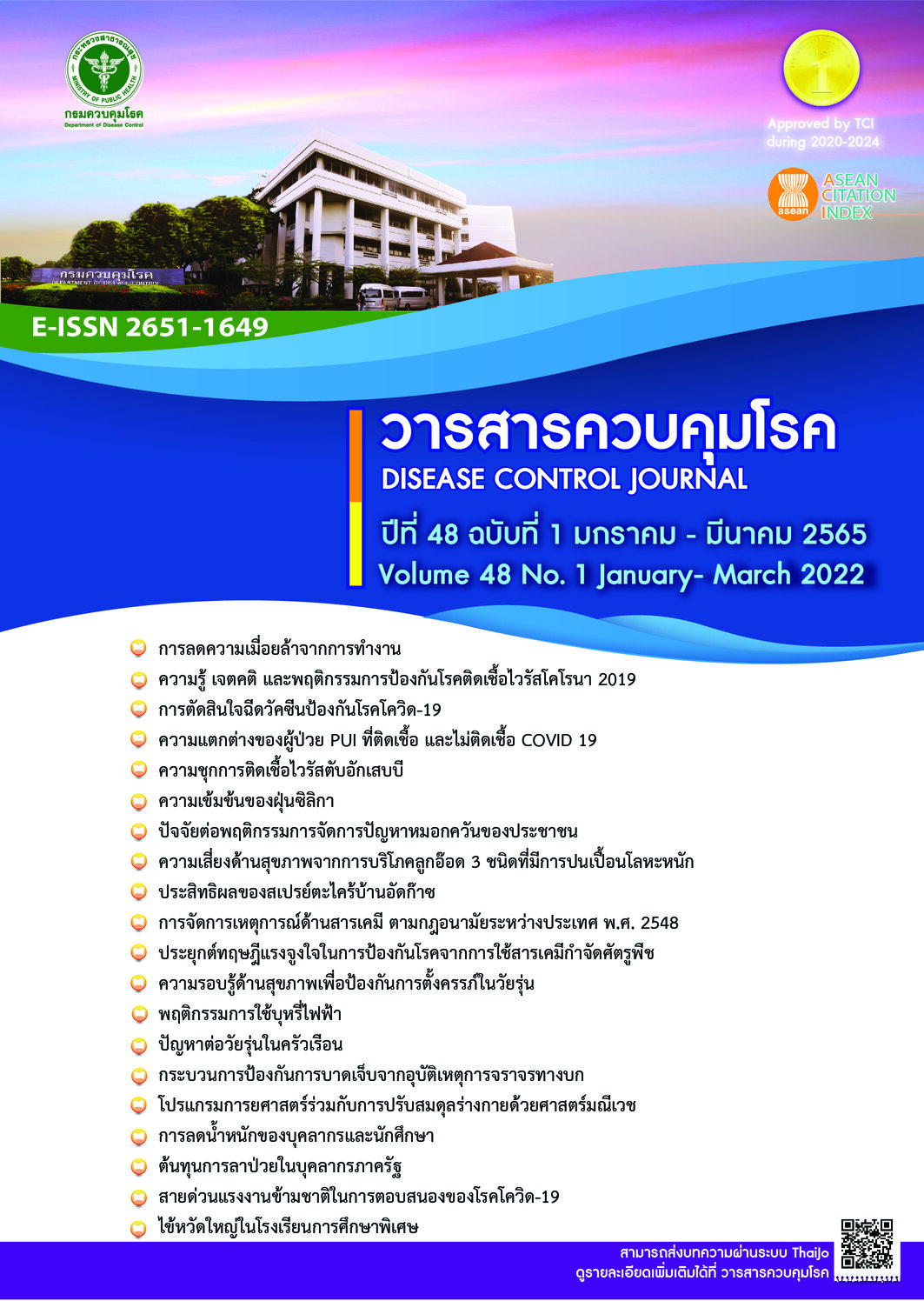Health risk assessment of exposure to heavy metals via consumption of three tadpole species found in surrounding electronic waste dumpsite in Kalasin province
DOI:
https://doi.org/10.14456/dcj.2022.8Keywords:
health risk assessment, heavy metals, electronic wasteAbstract
This research was conducted to assess health risks from exposure to heavy metals (arsenic, cadmium, chromium, lead, nickel, copper, and manganese) via consumption of three tadpole species (Kaloula pulchra, Fejervarya limnocharis, and Hoplobatrachus rugulosus) found in the surrounding areas of an electronic waste dumpsite in Khong Chai district, Kalasin province. Heavy metals contamination in water, sediment, and three tadpole species were assessed. The samples were analyzed for heavy metals using inductively coupled plasma optical emission spectrometry (ICP-OES). Health risk assessments through three tadpole species consumption was conducted based on hazard quotient (HQ). The results found that all heavy metal concentration in water samples exceeded the standards for water sources, whereas arsenic concentration in sediment samples was found to have exceeded the standards for soil used for the purposes other than agricultural and residential purposes. Regarding heavy metal contamination in three tadpole species, it was found that arsenic, chromium, and lead concentration exceeded the standard contamination in foods (at 0.1, 1.0 and 0.3 mg/kg, respectively), whereas cadmium concentration (0.5 mg/kg) exceeded the standard level only in Fejervarya limnocharis. Health risk assessment of exposure to heavy metals through the consumption of three tadpole species found that the HQ values of lead in three tadpole species were more than 1, whereas the HQ of arsenic was more than 1 only in Fejervarya limnocharis tadpole. E-waste disposal that was not appropriately managed has led to contamination of toxic substances into the environments and detrimental impacts to human health and ecosystem both in the short and long term.
Downloads
References
Ministry of Natural Resources and Environment (TH), Pollution Control Department. Thailand state of pollution report 2019. Bangkok: Style Creative House Co., Ltd; 2020. (in Thai)
Phuphisut O, Sangrajang S. Electronic waste and hazardous substances. Thai Journal of Toxicology 2010;25(1):67-76. (in Thai)
Neeratanaphan L, Khamma S, Benchawattananon R, Ruchuwararak P, Appamaraka S, Intamat S. Heavy metal accumulation in rice (Oryza sativa) near electronic waste dumps and related human health risk assessment. Human and Ecological Risk Assessment: An International Journal 2017;23(5):1086-98.
Phoonaploy U, Tengjaroenkul B, Neeratanaphan L. Effects of electronic waste on cytogenetic and physiological changes in snakehead fish (Channa striata). Environmental Monitoring and Assessment 2019;191(6):363.
Duruibe JO, Ogwuegbu MOC, Egwurugwu JN. Heavy metal pollution and human biotoxic effects. Journal of Physical Science 2007;2(5):112-8.
Nordberg GF. Biomarkers of exposure, effects and susceptibility in humans and their application in studies of interactions among metals in China. Toxicology Letters 2010;192(1):45-9.
Jarup L. Hazards of heavy metal contamination. British Medical Bulletin 2003;68:167-82.
Wei L, Ding G, Guo S, Tong M, Chen W, Flanders J, et al. Toxic effects of three heavy metallic ions on Rana zhenhaiensis tadpoles. Asian Herpetological Research 2015;6(2):132-42.
Sign P, Dey M, Ramanujam SN. Bioaccumulation of heavy metals in anuran tadpoles: A study in Barak Valley, Assam. International Journal of Aquatic Biology 2016;4(3):171-8.
Srivastav AK, Srivastav S, Suzuki N. Acute toxicity of a heavy metal cadmium to an Anuran, the Indian skipper frog Rana cyanophlyctis. International Journal of Toxcicology 2016;10(5):39-43.
Thanomsangad P, Junsong R, Neeratanaphan L, Appamaraka S, Tengjaroenkul B. Cytotoxic evaluation of heavy metal in frog (Hoplobatrachus rugulosa) around electronic waste landfill area. Thai Journal of Science and Technology 2018;26(1):172-84.
American Public Health Association (APHA). Standard methods for the examination of water and wastewater. 21st ed. Washington, DC: American Public Health Association; 2005.
Chand V, Prasad S. ICP-OES assessment of heavy metal contamination in tropical marine sediments: A comparative study of two digestion techniques. Microchemical Journal 2013;111:53-61.
Fu J, Zhou Q, Liu J, Lui W, Wang T, Zhang Q, et al. High levels of heavy metals in rice (Oryza sativa L.) from a typical open dumping of e-waste area in southeast China and its potential risk to human health. Chemosphere 2008;71:1269-75.
National Bureau of Agricultural Commodity and Food Standards (TH). Food consumption data of Thailand. Bangkok: National Bureau of Agricultural Commodity and Food Standards; 2016. (in Thai)
Knoema. World and regional statistics: Thailand-life expectancy at birth [Internet]. New York: Knoema; 2020 [cited 2021 July 14]. Available from: https://knoema.com/atlas/Thailand/topics/Demographics/Age/Life-expectancy-at-birth
US Environmental Protection Agency. Risk based concentration table. Washington, DC: US Environmental Protection Agency; 2000.
US Environmental Protection Agency, Office of Research and Development, National Center for Environmental Assessment. Exposure factors handbook volume 1-general factors (EPA/600/P-95/002Fa). Washington, DC: US Environmental Protection Agency; 1997.
Pollution Control Department (TH). Surface water quality standards. notification of the National Environmental Board no. 20. Bangkok: Pollution Control Department; 2000. (in Thai)
Pollution Control Department (TH). Soil quality standards for habitat and agriculture. Notification of the National Environmental Board, No. 25. Bangkok: Pollution Control Department; 1992. (in Thai)
Pollution Control Department (TH). The standard levels of heavy metals in tissues of aquatic animals. Bangkok: Pollution Control Department; 2020. (in Thai)
Lee CH, Chang SL, Wang KM, Wen LC. Management of scrap computer recycling in Taiwan. Journal of Hazardous Materials 2000;73:209-20.
Unrine JM, Hopkins WA, Romanek CS, Jackson BP. Bioaccumulation of trace elements in omnivorous amphibian larvae: Implications for amphibian health and contaminant transport. Environmental Pollution 2007;149(2):182-92.
Tong S, von Schirnding YE, Prapamontol T. Environmental lead exposure: a public health problem of global dimensions. Bull World Health Organ 2000;78(9):1068-77.
IARC Working Group on the Evaluation of Carcinogenic Risks to Human. Inorganic and Organic Lead Compounds. IARC Monographs on the Evaluation of Carcinogenic Risks to Humans 2006;87:1-16.
Centeno JA, Mullick FG, Martinez L, Page NP, Gibb H, Longfellow DT, et al. Pathology related to chronic arsenic exposure. Environmental Health Perspectives 2002;110(suppl5):883-6.
Downloads
Published
How to Cite
Issue
Section
License
Copyright (c) 2022 Disease Control Journal

This work is licensed under a Creative Commons Attribution-NonCommercial-NoDerivatives 4.0 International License.
Articles published in the Disease Control Journal are considered as academic work, research or analysis of the personal opinion of the authors, not the opinion of the Thailand Department of Disease Control or editorial team. The authors must be responsible for their articles.






